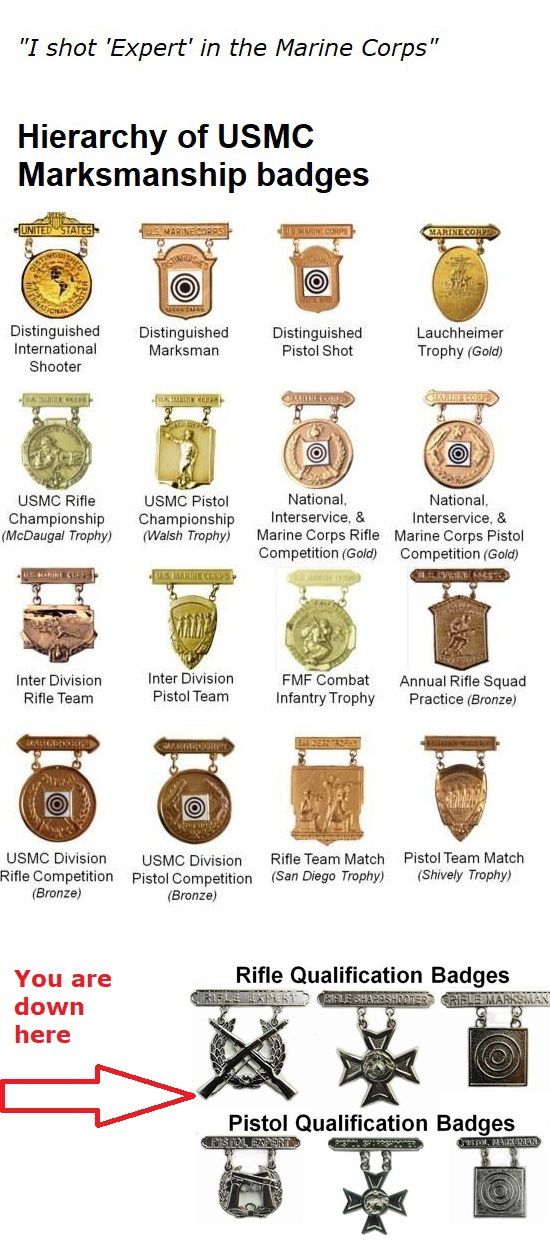Shooting Skill Classifications Explained (for real)
Every good shooting organization has a Classification system to stratify shooters by skill level. Here is an example of how it works.
When is an “Expert” not an expert? What is the difference? The military, police, and civilian shooters throw terms like “Sharpshooter” and “Expert” around and they do NOT always mean the same thing. Even within the NRA, Classification and Qualification are very different things, including when the names appear the same.
The typical rating scheme:
High Master
Master
Expert
Sharpshooter
Marksman
Novice
Other organizations use a letter scheme instead. For example, USPSA (United States Practical Shooting Association) Classification starts at ‘D’ class, up to ‘A’ class, then Master and Grand Master. The Amateur Trapshooting Association has D to A, then ‘AA’ and ‘AAA’
Military shooting badges are worn on the dress uniform in this order of importance:
International Distinguished
President’s Hundred
Interservice Competition
Distinguished Rifleman
Distinguished Pistol Shot
Silver EIC (20 or more “Leg” points)
Bronze EIC (any number of earned “Leg” points)
Expert
Sharpshooter
Marksman
There are also branch-specific badges as well. For the U.S. Marine Corps:
For the U.S. Army:
A “Marksman” rating in competition shooting is oftentimes more difficult to earn than a current “Expert” qualification in routine military or law enforcement testing. In one test of police officers shooting the IDPA 5x5 Classifier, 2/3 were in the bottom Novice bracket, 1/3 made Marksman, and none shot better than that. However, because most public sector marksmanship training is originally derived from organized civilian shooting, the names are the same and have stuck even as the standards were reduced. Here’s the breakdown.
First, there are the rankings used to describe Classification in competitive shooting. I’ll use Conventional events recognized by the NRA as an example. Those rankings are only earned by competing against other shooters in events tracked by the host organization; for NRA Classifications the event has to be an Approved or Registered tournament. When a competition shooter talks about being a “Master Class” shooter (or “Sharpshooter” or “Expert”) that’s what they mean.
An “Expert” Classification earned this way (not to mention “Master”, “High Master”/”Grand Master”) through open competition is the most challenging rating to earn and requires the most shooting skill.
The Distinguished Rifleman or Pistol Shot badge is a different award earned by accumulating 30 “Leg” points over your competitive shooting career in Service Rifle or Service Pistol matches. Called Excellence in Competition, these points are only awarded at EIC events recognized by the Civilian Marksmanship Program, US Army, and/or US Marine Corps. It can be difficult to earn and is prestigious.
The various branches also host shooting competitions and have badges for them. As the Marine badges above indicate, they have Marine-only awards such as the Lauchheimer, McDougal, and Walsh trophies.
Winchester/NRA Marksmanship Qualification is a self-paced program designed to let shooters improve their shooting skills and track their progress by successfully firing certain set drills on prescribed courses of fire. This program is entirely self-paced and the NRA does not actually track or officially award the qualification levels. It’s all pretty much on the honor system.
The self-paced program has value as it gives concrete goals to work towards and, more importantly, gives a way to track shooting progress. It was designed to prepare a new shooter for higher-level organized shooting, such as competition. A “Distinguished Expert” on a Marksmanship Qualification Program course is roughly equal to a “Sharpshooter” Classification in competition.
Lastly, is Qualification within the military and police departments. Despite sharing the stratification names (marksman, sharpshooter, expert), military and police qualification is the lowest skill level of all. Most public-sector shooting courses were originally derived from organized civilian events, which is why the qualification and classification rating names are the same. However, while competition shooters have progressively improved over the decades and made their standards more challenging, most military and police department qualifications have allowed non-marksmen to handle training and have downgraded the standards. Nearly every change to military qualification standards since World War 2, particularly in the U.S. Army and Marine Corps, has reduced the standard. Thus, an “Expert” Qualification rating (not to mention Sharpshooter or Marksman) on an Army, Marine, or police qualification course is the lowest rating of all.
Also, consider the size of the targets used:
The entire EIC target used in Service Conditions competition is smaller than the center (five ring) of USMC qualification targets. As shown, a miss that scores zero in competition still scores 80% (four points) during USMC qualification. This is even more pronounced when compared to targets used in conventional competition.






The reason the USMC qualification targets are what they are is because they a) represent prone and kneeling humans which coincides with USMC doctrine and b) represent humanoid forms in order to train riflemen to engage humans (See "On Killing" by Grossman). By engaging humanoid targets riflemen learn to establish aiming points on humanoid shapes.
Having said all that when I was running the marksmanship package at the scout-sniper instructor school in Quantico I used NRA repair centers for developing zeroes and initial training but when we qualified, the students we went with FBI silhouettes. When I was an instructor/NCOIC of the National Guard sniper school, we used NRA centers for all KD training including qualification then went with silhouettes for unknown distance.
My point is there are reasons why the military uses the silhouettes.
"Marksmanship is just not important to about 3/4ths of the Marines and maybe 4/5ths of the Army."
"target size/qual scores are influenced by a desire to not fail out too many people."
Everyone involved in military small arms training must come to terms with these truths.